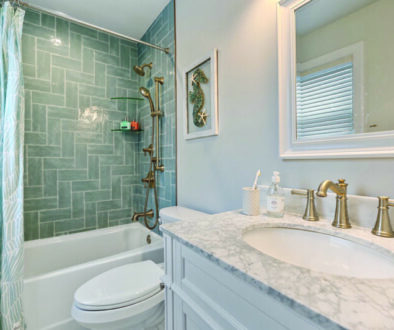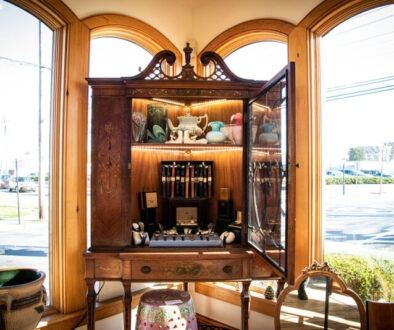Narcissomania

She wore her yellow sun-bonnet,
A. A. Milne
She wore her greenest gown;
She turned to the south wind
And curtsied up and down.
She turned to the sunlight
And shook her yellow head,
And whispered to her neighbor:
“Winter is dead.”
I fell in love with daffodils when I first started to come to Cape May in the wintertime. I was driving down Route 9 and I couldn’t believe my eyes – the road was lined in yellow daffodils, and it was February!
Characterized by six petal-like tepals that surround a cup or trumpet-shaped corona and perched upon a leafless hollow stem, daffodils are one of the happiest flowers you can grow. They are so cheerful; they simply make you smile. And, unlike fussy tulips, they are easy to grow and return year after year, completely unbothered by deer, rodents, and disease. Some are even fragrant. Just watch the drainage. If the soil is too wet for too long, the bulbs will rot.
They come in yellow, white, cream, peach, orange, and pink. I must admit I have never seen a true pink daffodil. The “pink” varieties tend to be peach colored. The same is true for any of them with the word red in their name—they are usually orange. They grow from six to 30 inches tall and prefer at least six hours of sunlight each day. But don’t be afraid to plant them under a tree. Remember, trees don’t leaf-out until after daffodils bloom. So, sites that are shady in summer may be just fine for these early bloomers.
The Early Bird Catches the Worm
Ordinary daffodil bulbs are inexpensive and widely available at your local garden centers as well as Home Depot and Lowe’s. As a rule of thumb, look for the largest bulbs available. They are more mature and will produce better flowers. Of course, smaller varieties naturally have smaller bulbs. If you are looking for something a little different, there are many fabulous purveyors online such as Breck’s, Brent & Becky’s, Colorblends, DutchGrown, Holland Bulb Farms, John Scheeper’s (Van Engelen, Inc.), K. van Bourgondien (DutchBulbs.com) and Longfield Gardens. But don’t procrastinate. The most sought-after varieties sell out quickly and when they’re gone, they’re gone ‘til next year.
Growing
As much as I adore daffodils, you won’t see any in my yard this year. I simply didn’t get to it last fall, which is when you need to plant them because they require 12 to 16 weeks of winter chill in order to bloom. With careful selection and diversification, you can enjoy them for eight to 12 weeks beginning in late winter.
Plant them in groups for maximum impact. Dig a hole to a depth of two to three times the diameter of the bulb and space them six to 12 inches apart depending on how immediate an impact you want them to have. If you are planting a delicate variety like Erlicheer, place half a dozen or so bulbs in each hole, but don’t let the bulbs touch each other. Whatever you do, don’t line them up in a row like little soldiers!
After they bloom it is crucial to leave them alone. You can cut off the spent flower stems, but you must leave the leaves until they turn yellow and dry, and you are able to remove them with just a gentle tug. This allows energy to return down into the bulb so it can produce another flower next year. Don’t be tempted to braid or tie the foliage to neaten things up. It will only hinder the process. Therefore, I do not recommend planting them in beds where you are going to put annuals unless there is room to intersperse them. Better to camouflage the untidy mess by planting your bulbs among late blooming perennials. Ornamental grasses, hostas, liriope, phlox, and daylilies also all make great companions.
Divide daffodils when they start to get crowded (the number of blooms will decrease). Dig them up about one month after they bloom while the foliage is still attached so you can tell where they are!
By the way, daffodils are perfect in pots. They also make great cut flowers, but they don’t play well with others in a vase. When they are cut, they emit a fluid that can cause other flowers to wilt.
Too Many to Count
It is estimated there are over 32,000 varieties of narcissi. The American Daffodil Society groups them into 13 different types, most of which are known by the common name daffodil, plus one type that is usually referred to as jonquil.
Trumpet – cup at least as long as its petals; one flower per stem. King Alfred is a very old variety and probably the best-known trumpet daffodil. It is the epitome of big, yellow, and showy. Newer selections like Dutch Master, Gigantic Star, and Yellow River are equally spectacular—as are British Gamble, Goblet, Las Vegas, and Mount Hood.
Large-cupped – cup is more than one-third the length of its petals; one flower per stem. Carlton, Curly, Fortissimo, Gigantic Star, Ice Follies, Magic Charm, Nightlife, Red Devon, Riot, Stainless, and Salome.
Small-cupped – cup is no more than one-third the length of its petals; one flower per stem. Altruist, Barrett Browning, Sinopel, and Xit.
Double – clustered cups and petals; one or more flowers per stem. Fragrant like a gardenia, Cheerfulness is the one that started it all. Bridal Crown, Delnashaugh, Erlicheer, Golden Ducat, Lingerie, My Story, Peach Cobbler, Petit Fours, Replete, Sir Winston Churchill, Tahiti, and White Lion.
Jonquilla – small, fragrant flowers with flat petals and narrow leaves; one to five flowers per stem. Blushing Lady, Cosmopolitan, Golden Echo, Kedron, Pipet, and Sun Disc.
Tazetta – clusters of florets with broader leaves and stems and a musky fragrance that some people find offensive; three to 20 flowers per stem. Paper White is the most well-known. Avalanche, Cragford, Falconet, Geranium, Golden Dawn, and Minnow.
Split Corona – cup is split open, usually at least halfway. Cassata, Lemon Beauty, Love Call, Mallee, Sunny Side Up and Zinzi.
Other classifications include Triandrus, Cyclamineus (shade tolerant), Poeticus, Bulbocodium, Species, wild variants, and wild hybrids and Miscellaneous. All of which are not as readily available or as interesting to grow (unless you are a true “Narcissusphile”)—with one exception. Tete-a-Tete (a Cyclamineus), is a very popular miniature sold at Easter Time. Please note: keep them in a cool location until you are ready to display them as they will continue to “grow” and become so tall they will flop over in only a few days.




